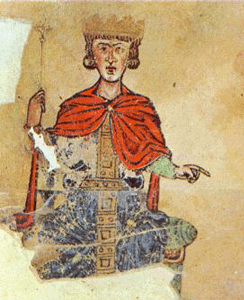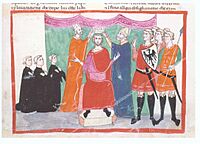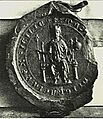Manfred, King of Sicily facts for kids
Quick facts for kids Manfred |
|
|---|---|

Contemporary depiction of Manfred from the De arte venandi cum avibus - Vatican Library ms. pal. lat. 1071 , fol. 1v (13th-century)
|
|
| King of Sicily | |
| Reign | 1258 – 26 February 1266 |
| Coronation | 10 August 1258 |
| Predecessor | Conradin |
| Successor | Charles I |
| Born | Manfred Lancia 1232 Venosa, Kingdom of Sicily |
| Died | 26 February 1266 (aged 34) Benevento, Kingdom of Sicily |
| Spouse |
Beatrice of Savoy
(m. 1247; died 1259)Helena Angelina Doukaina
(m. 1259) |
| Issue | Constance, Queen of Sicily Beatrix Henry Anselm Frederick (illeg.) Flordelis |
| House | Hohenstaufen |
| Father | Frederick II, Holy Roman Emperor |
| Mother | Bianca Lancia |
Manfred (Sicilian: Manfredi di Sicilia; 1232 – 26 February 1266) was the last King of Sicily from the Hohenstaufen dynasty, reigning from 1258 until his death. The natural son of the Holy Roman Emperor Frederick II, Manfred became regent over the kingdom of Sicily on behalf of his nephew Conradin in 1254. As regent he subdued rebellions in the kingdom, until in 1258 he usurped Conradin's rule. After an initial attempt to appease Pope Innocent IV he took up the ongoing conflict between the Hohenstaufens and the papacy through combat and political alliances. He defeated the papal army at Foggia on 2 December 1254. Excommunicated by three successive popes, Manfred was the target of a Crusade (1255–66) called first by Pope Alexander IV and then by Urban IV. Nothing came of Alexander's call, but Urban enlisted the aid of Charles of Anjou in overthrowing Manfred. Manfred was killed during his defeat by Charles at the Battle of Benevento, and Charles assumed kingship of Sicily.
Early life
Manfred was born in Venosa. Frederick II appears to have regarded him as legitimate, and by his will named him as Prince of Taranto. Frederick named Manfred's half-brother Conrad IV king of Germany, Italy and Sicily, but Manfred was regent of Sicily while Conrad was in Germany. Manfred, who initially bore his mother's surname, studied in Paris and Bologna and shared with his father a love of poetry and science.
At Frederick's death in 1250, Manfred, although only about 18 years old, acted loyally and with vigour in the execution of his trust. The Kingdom was in turmoil, mainly due to rebellions spurred by Pope Innocent IV. Manfred was able to subdue numerous rebel cities, with the exception of Naples. Manfred attempted in 1251 to make concessions to Pope Innocent to stave off the prospect of war, but the attempt failed. When Conrad IV, Manfred's legitimate brother, appeared in southern Italy in 1252, his authority was quickly and generally acknowledged. Conrad quickly stripped Manfred of all his fiefs by limiting his authority solely to the principality of Taranto. In October 1253, Naples fell into the hands of Conrad. Conrad made the pope the guardian of Conradin, his infant son, and named the Margrave Berthold of Hohenberg, a powerful German baron, as Conradin's regent.
In May 1254 Conrad died of malaria at the age of twenty-six. Manfred, after refusing to surrender Sicily to Innocent IV, accepted the regency on behalf of Conradin. The pope however, having been named guardian of Conradin, excommunicated Manfred in July 1254. The regent decided to open negotiations with Innocent. As part of a treaty made in September 1254, Manfred submitted, and accepted the title of Papal vicar for southern Italy But Manfred—his suspicions aroused by the demeanour of the papal retinue and annoyed by the occupation of Campania by papal troops—fled to the Saracens at Lucera. Aided by Saracen allies, he defeated the papal army at Foggia on 2 December 1254, and soon established his authority over Sicily and the Sicilian possessions on the mainland. In that year Manfred supported the Ghibelline communes in Tuscany, in particular Siena, to which he provided a corps of German knights that was later instrumental in the defeat of Florence at the Battle of Montaperti. He thus reached the status of patron of the Ghibelline League. Also in that year Innocent died, succeeded by Alexander IV, who immediately excommunicated Manfred. In 1257, however, Manfred crushed the papal army and settled all the rebellions, imposing his firm rule of southern Italy and receiving the title of vicar from Conradin.
-
Coat of arms of King Manfred
Kingship

On 10 August 1258, taking advantage of Conradin's rumoured death, Manfred was crowned King of Sicily at Palermo. The falsehood of this report was soon manifest; but the new king, supported by the popular voice, declined to abdicate and pointed out to Conradin's envoys the necessity for a strong native ruler. The pope, to whom the Saracen alliance was a serious offence, declared Manfred's coronation void. Undeterred by the excommunication Manfred sought to obtain power in central and northern Italy, where the Ghibelline leader Ezzelino III da Romano had disappeared. He named vicars in Tuscany, Spoleto, Marche, Romagna and Lombardy. After Montaperti he was recognized as protector of Tuscany by the citizens of Florence, who did homage to his representative, and he was chosen "Senator of the Romans" by a faction in the city. His power was also augmented by the marriage of his daughter Constance in 1262 to Peter III of Aragon.
Terrified by these proceedings, the new Pope Urban IV excommunicated him. The pope first tried to sell the Kingdom of Sicily to Richard of Cornwall and his son, but in vain. In 1263 he was most successful with Charles I of Anjou, a brother of King Louis IX of France, who accepted the investiture of the kingdom of Sicily at his hands. Hearing of the approach of Charles, Manfred issued a manifesto to the Romans, in which he not only defended his rule over Italy but even claimed the imperial crown.
Charles' army, some 30,000 strong, entered Italy from the Col de Tende in late 1265. He soon reduced numerous Ghibelline strongholds in northern Italy and was crowned in Rome in January 1266, the pope being absent. On 20 January he set southwards and waded the Liri river, invading the Kingdom of Sicily. After some minor clashes, the rival armies met at the Battle of Benevento on 26 February 1266, and Manfred's army was defeated. The king himself, refusing to flee, rushed into the midst of his enemies and was killed. Over his body, which was buried on the battlefield, a huge heap of stones was placed, but afterwards with the consent of the pope the remains were unearthed, cast out of the papal territory, and interred on the bank of the Garigliano River, outside of the boundaries of Naples and the Papal States.
At the Battle of Benevento Charles captured Helena, Manfred's second wife, and imprisoned her. She lived five years later in captivity in the castle of Nocera Inferiore where she died in 1271. Manfred's son-in-law Peter III eventually became King Peter I of Sicily from 1282 after the Sicilian Vespers expelled the French from the island again.
The modern city of Manfredonia was built by King Manfred between 1256–1263, some kilometers north of the ruins of the ancient Sipontum. The Angevines, who had defeated Manfred and stripped him of the Kingdom of Sicily, renamed it Sypontum Novellum ("New Sypontum"), but that name never imposed.
Marriages and children
Manfred was married twice:
- His first wife was Beatrice, daughter of Amadeus IV, count of Savoy, by whom he had a daughter, Constance, who was married to the heir to the Aragonese throne, the future King Peter III of Aragon, on 13 June 1262.
- Manfred's second wife was Helena Angelina Doukaina, daughter of Michael II Komnenos Doukas, ruler of the despotate of Epirus, who made this marriage to ally with Manfred after being attacked by him at Thessalonica. Helena and Manfred had four children: Beatrix, Henry [Enrico], Anselm [Azzolino] and Frederick. Helena and all her children were captured by Charles of Anjou after Manfred's death in 1266. Helena died in prison in Nocera in 1271. Her three sons with Manfred – the oldest only four years old at the time – were imprisoned in the Castel del Monte until 1299, when Charles II had them unchained and moved to the Castel dell'Ovo. Their living conditions were exceptionally miserable compared to the norm for noble prisoners. Kept in darkness, in heavy chains and with barely enough food to survive they became "blind and half-mad". The stress of the move proved too much for Azzolino, who died soon after (in 1301). Henry survived another eighteen years, dying aged fifty-four on 31 October 1318, "half-starved, half-mad and probably blind". Beatrix in contrast had been released on the orders of the Aragonese commander Roger of Lauria following a battle off Naples in 1284. She went on to marry Manfred IV, Marquis of Saluzzo. The eldest son, Frederick, escaped his prison and fled to Germany. He spent time in several European courts before dying in Egypt in 1312.
Manfred had at least one illegitimate child, a daughter named Flordelis (d. 27 February 1297), who married Ranieri Della Gherardesca, Count of Donoratico and Bolgheri.



